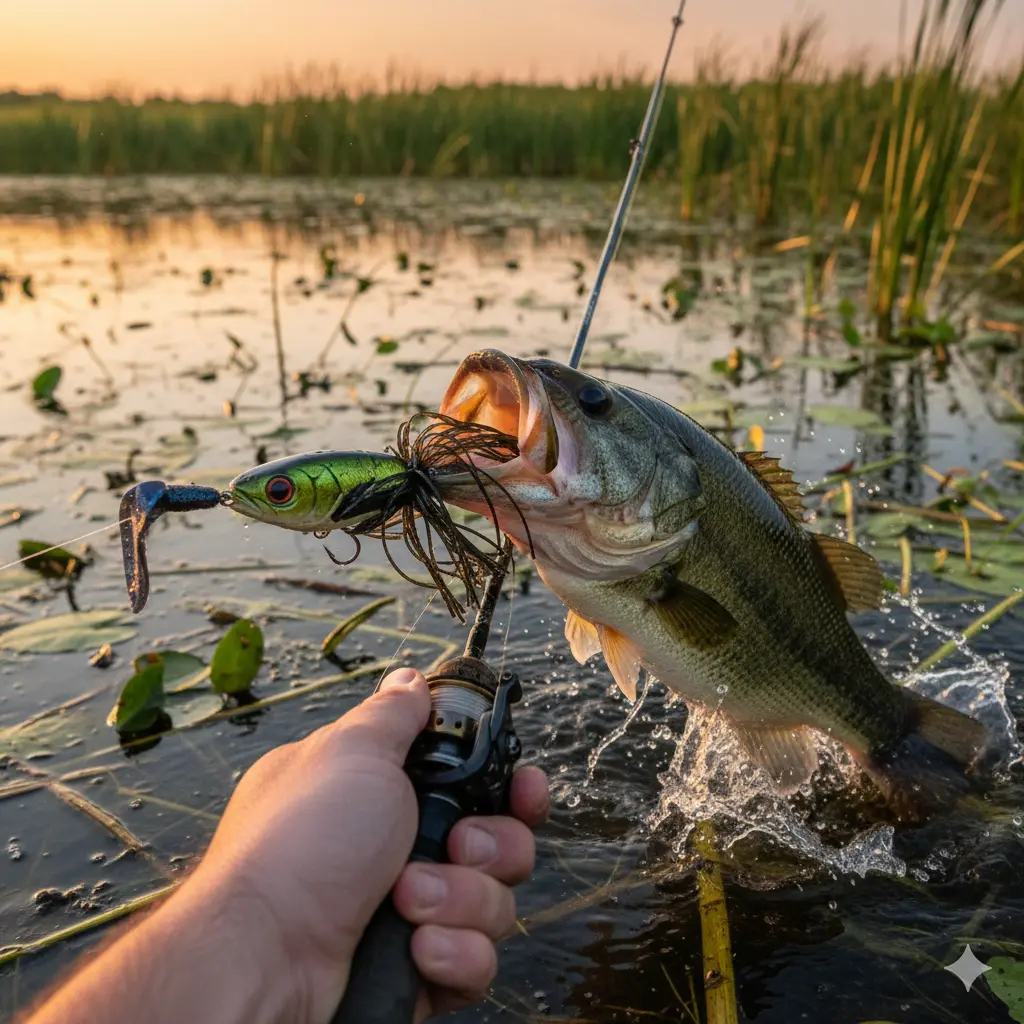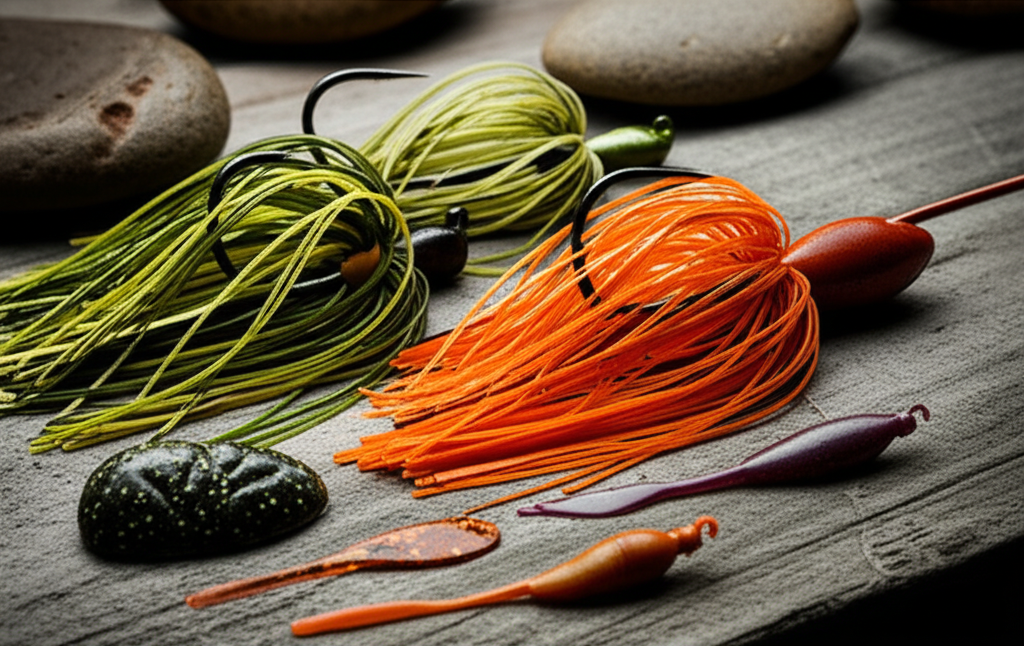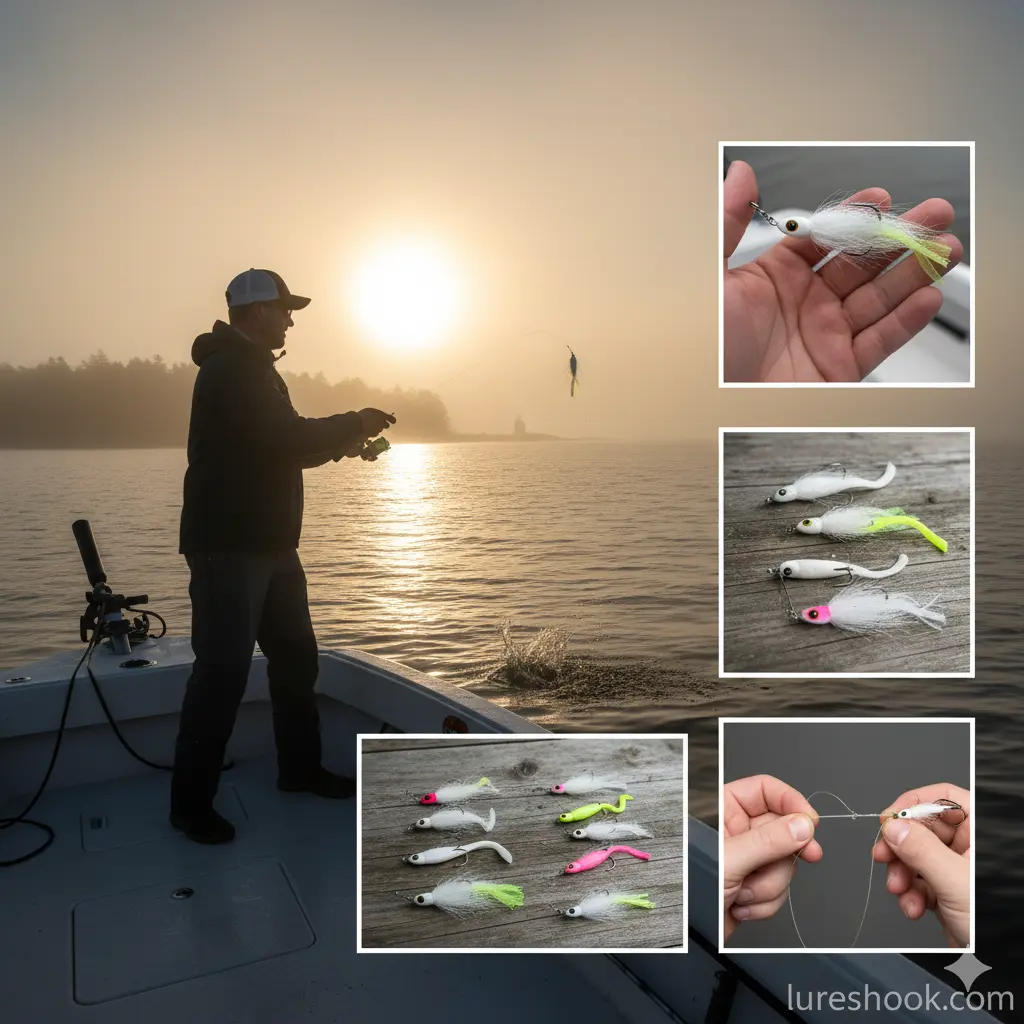The Silent Hunter: Your Ultimate Guide to Mastering Swim Jig Fishing in 2025
Enter the stealthy world of the swim jig – a master of disguise, a silent hunter, and arguably one of the most versatile lures in your tackle box. Our ultimate guide unravels the secrets behind this unassuming powerhouse, teaching you everything from head shapes and skirt patterns to killer retrieves that will trigger explosive strikes from wary predators.
Table of Contents
- What Are Swim Jigs?
- Why Swim Jigs Are the Ultimate Stealth Weapon
- Types of Swim Jigs & Their Adaptations
- Rigging Your Swim Jig for Maximum Deception
- Essential Swim Jig Fishing Techniques
- Species-Specific Swim Jig Strategies
- Essential Gear for Swim Jig Fishing
- Pro Tips & Advanced Swim Jig Tactics
- Frequently Asked Questions About Swim Jigs
What Are Swim Jigs?
A swim jig is a specialized type of fishing jig designed to be retrieved steadily through the water, mimicking a swimming baitfish, crawfish, or even a small bluegill. Unlike a traditional flipping or pitching jig, which is designed to be worked vertically or hopped along the bottom, the swim jig is built for horizontal travel. It typically consists of a streamlined, weighted head, a sturdy single hook, a dense weedguard that allows it to glide through cover, and a flowing silicone or living rubber skirt that pulsates and breathes in the water. When paired with the right soft plastic trailer, a swim jig becomes an incredibly lifelike imitation that’s practically irresistible to hungry predators.
Why Swim Jigs Are the Ultimate Stealth Weapon
Fishing with swim jigs offers a unique blend of subtlety and power, making them a secret weapon for many anglers:
- Unmatched Weedless Design: The combination of a pointed head and a robust weedguard allows swim jigs to slither through dense grass, lily pads, wood, and other heavy cover with minimal snagging.
- Incredible Versatility: They can be fished at various depths, from just below the surface to several feet down, and can imitate a wide range of forage.
- Subtle, Lifelike Action: The flowing skirt and chosen trailer create a natural swimming action that looks incredibly realistic, triggering bites from even the most wary fish.
- Quiet & Non-Intimidating: Unlike noisy crankbaits or splashy topwater lures, swim jigs offer a stealthy presentation that won’t spook pressured fish.
- Big Fish Magnet: Their ability to penetrate dense cover and their realistic profile often tempt larger, more elusive predators.
When to Use Swim Jigs
Swim jig fishing excels in these situations:
- Heavy Cover: Dense grass beds, lily pads, submerged timber, cattails, and around docks.
- Murky or Stained Water: The pulsing skirt creates a strong visual profile and vibration that fish can easily locate.
- Post-Spawn & Summer Months: When fish are actively relating to cover and ambushing prey.
- Around Baitfish Schools: When fish are feeding on shad, shiners, or bluegill, a swim jig is a perfect imitation.
- When Fish Are Pressured: Their subtle presentation can often draw bites when other, more aggressive lures fail.
Skill Level: Intermediate to Advanced
While the basic retrieve is straightforward, mastering the nuanced retrieves, understanding depth control, and making precise casts into heavy cover requires practice and experience.
Beginner Rating: 6/10 – Easy to cast, but finesse and precision elevate its effectiveness.
Types of Swim Jigs & Their Adaptations
Swim jigs come in various head shapes, each designed to excel in different types of cover and impart specific actions to your lure.
1. Pointed/Cone Heads
The ultimate grass and weed penetrators.
These jigs feature a sharply pointed nose that allows them to slice through dense vegetation like hydrilla, milfoil, and reeds with minimal resistance. They come out of cover clean, making them less prone to snagging grass.
- Ideal For: Thick grass beds, lily pads, heavy vegetation.
- Action: A subtle wobble, designed for straight-line retrieves through cover.
2. Arky Heads
The versatile all-rounder for various cover.
Arky heads have a slightly more rounded, bullet-like profile than pointed heads. They are a good compromise, offering decent weed penetration while also performing well around wood and rocks.
- Ideal For: Sparse grass, wood, docks, rocks, open water.
- Action: Can be swam, hopped, or even pitched around varied structure.
3. Bladed Swim Jigs (Chatterbaits)
The vibrating powerhouses for aggressive reaction bites.
While technically a distinct category, bladed swim jigs (like the ChatterBait) are a close cousin. They feature a hexagonal blade attached to the jighead, which vibrates wildly during the retrieve, creating immense flash and thumping action.
- Ideal For: Stained water, wind, covering water quickly, attracting aggressive fish.
- Action: High-frequency vibration, strong wobble, aggressive flash.
4. Skirt Materials & Colors
Swim jigs utilize various skirt materials, most commonly silicone or living rubber. The density and cut of the skirt, along with its color, significantly impact the lure’s profile and appeal.
- Natural Colors: Green pumpkin, black/blue, crawfish patterns for clear water and mimicking natural forage.
- Baitfish Colors: White, shad patterns, chartreuse for imitating baitfish.
- Bright Colors: Chartreuse, white/chartreuse, or even pink for murky water or aggressive reaction bites.
Rigging Your Swim Jig for Maximum Deception
The right trailer and line setup are critical for optimizing your swim jig’s action and hooking power.
1. The Trailer: The Heart of the Action
The soft plastic trailer you choose will significantly impact the swim jig’s action, profile, and fall rate. Experimentation is key!
- Paddle Tail Swimbait: Creates a realistic swimming motion and vibration, perfect for imitating baitfish.
- Grub/Curley Tail: Adds a subtle, wiggling action, great for a more finessy presentation.
- Craw/Creature Bait: Mimics a fleeing crawfish or other aquatic creatures, especially effective around wood and rocks.
- Fluke/Minnow Style: Gives a more streamlined, darting action, good for open water or around sparse cover.
2. Trailer Hook (Optional)
If you’re getting short strikes (fish nipping at the tail), consider adding a small, single trailer hook (secured with a piece of silicone tubing) to increase your hook-up ratio.
3. The Knot
- Palomar Knot: A strong, reliable knot for tying braided line directly to the jig’s eye.
- Improved Clinch Knot: Another strong option for all line types.
4. Line Selection
- Braided Mainline with Fluoro Leader: For maximum sensitivity and strength, spool with 30-50 lb braided line. Attach a 12-20 lb fluorocarbon leader with an FG or double uni knot. The fluoro leader provides invisibility and abrasion resistance.
- Fluorocarbon Mainline: Can be used as a main line (15-20 lb) for its invisibility and low stretch, but can be prone to tangles on a baitcaster.
Essential Swim Jig Fishing Techniques
The beauty of the swim jig lies in its straightforward yet versatile retrieve. Master these methods to unlock its full potential.
1. The Steady Swim
- Technique: Cast your swim jig out and retrieve it at a slow to moderate, steady pace. Keep your rod tip slightly elevated. The goal is a consistent, natural swimming motion.
- Key Insight: This mimics a baitfish cruising through cover. Let the jig’s design and trailer do the work.
- Best For: Searching for active fish, working weed lines, or covering open flats.
2. The “Tick & Go” (Through Grass)
- Technique: Cast into or over grass. As the jig contacts the vegetation, give a slight, sharp “pop” of the rod tip to pull it free. Immediately resume your steady retrieve.
- Key Insight: The sudden action as it comes free from the grass often triggers a reaction strike. This is a primary technique for swim jig fishing.
3. The Pause & Drop
- Technique: After a few feet of steady retrieve, pause for a second or two, allowing the jig to slowly fall. Then, resume your retrieve.
- Key Insight: This mimics a baitfish that has stopped or been injured, often tempting a following fish to commit.
4. Around Docks & Structure
- Technique: Make precise casts under and around dock pilings, boat lifts, and submerged wood. Let the jig fall for a moment, then begin your retrieve, often with a subtle “tick” off the structure.
- Key Insight: Fish often ambush prey in these areas. The weedless nature of the swim jig makes it ideal for this heavy cover.
Species-Specific Swim Jig Strategies
While a bass angler’s favorite, swim jigs are also deadly for other toothy and aggressive predators.
1. Bass Fishing with Swim Jigs ⭐⭐⭐
- Target Species: Largemouth Bass, Smallmouth Bass.
- Technique: The swim jig is a year-round bass producer. Fish it through grass, around laydowns, parallel to seawalls, and under docks. Match trailer to forage; big paddle tails for shad, craws for bottom-oriented fish.
- Top Colors: Green pumpkin, black/blue, white, shad patterns (white/silver).
2. Pike & Musky with Swim Jigs ⭐⭐
- Target Species: Northern Pike, Musky.
- Technique: Use larger, heavier swim jigs (1/2 oz+) with big paddle tail or fluke-style trailers. Retrieve steadily along weed edges, through sparse cover, or over flats. The weedless design is perfect for their preferred habitat.
- Top Colors: Pike patterns, perch, firetiger, white/chartreuse. Use a wire leader!
3. Redfish & Speckled Trout with Swim Jigs ⭐⭐
- Target Species: Redfish, Speckled Trout.
- Technique: In saltwater, swim jigs with shrimp or baitfish trailers are deadly. Cast them over oyster beds, through shallow grass flats, or along mangrove shorelines.
- Top Colors: White, chartreuse, natural shrimp, silver/blue.
Essential Gear for Swim Jig Fishing
A properly balanced rod, reel, and line setup is crucial for precise casting, feeling bites, and powerful hooksets.
1. Rod Selection
- Power/Action: A 7′ to 7’6″ medium-heavy (MH) to heavy (H) power baitcasting rod with a fast (F) action tip. This provides the backbone to pull fish out of heavy cover and a fast tip for precise casts and detecting subtle bites.
- Material: Graphite rods are generally preferred for their sensitivity and light weight.
2. Reel Selection
- Type: A baitcasting reel is universally preferred for swim jigging due to its power, casting accuracy, and ability to handle heavier lines.
- Gear Ratio: A medium to fast gear ratio (6.3:1 to 7.3:1) is ideal. This allows for controlled retrieve speeds while also providing enough power for strong hooksets and quick line pickup.
3. Line Selection
- Braided Line: The top choice for main line (30-65 lb test). Its zero stretch provides unmatched sensitivity for feeling subtle bites and incredible strength for ripping jigs through heavy cover.
- Fluorocarbon Leader: Essential with braid (12-20 lb test). It’s invisible underwater and provides abrasion resistance.
- Fluorocarbon Mainline: Can be used as a main line (15-20 lb) if you prefer a less visible setup, but be aware of its stiffness and memory on a baitcaster.
Pro Tips & Advanced Swim Jig Tactics
Elevate your swim jig game and entice even the most stubborn predators.
1. The Weight Advantage
- Match Weight to Depth/Cover: Use lighter jigs (1/4 – 3/8 oz) for shallower water or sparse cover, and heavier jigs (1/2 – 3/4 oz) for deeper water, windy conditions, or thicker vegetation to maintain contact and control.
2. Color Theory: Adapt to the Water
- Clear Water: Natural colors like green pumpkin, brown, or white/shad patterns.
- Stained/Murky Water: Black/blue, chartreuse, or vibrant white for increased visibility and contrast.
- Match Forage: If fish are targeting bluegill, use a bluegill-colored skirt and trailer.
3. The Trailer’s Role is Paramount
- Experiment: Don’t just stick to one trailer. A paddle tail creates thump; a fluke gives a subtle glide; a craw adds bulk and a defensive posture. The trailer dictates much of the jig’s action.
- Trim the Skirt: Sometimes trimming a few strands of the skirt can enhance the action of the trailer or create a smaller profile.
4. Power Hookset is Key
- Stout Rod, No Hesitation: Due to the single, heavy hook and often fishing in thick cover, a powerful hookset is vital. Use a strong, sweeping motion, driving the hook home.
5. Don’t Overwork It
- Subtlety is Strength: The swim jig is designed to be a natural presentation. Avoid overly aggressive jerking or twitching. A smooth, consistent retrieve is often all it takes.
Frequently Asked Questions About Swim Jigs
Q: What’s the ideal retrieve speed for a swim jig? A: There’s no single “ideal” speed. Start with a slow to moderate retrieve, letting the skirt and trailer do their work. Vary your speed until you find what the fish prefer on that day. Sometimes a faster “burn” is needed to trigger a reaction strike. Q: Can I use a swim jig without a trailer? A: While possible, a soft plastic trailer is highly recommended. It significantly enhances the jig’s action, profile, and appeal, making it a much more effective lure. Q: What’s the best time of year for swim jig fishing? A: Swim jigs are productive year-round, but they truly excel from late spring through fall, particularly during the summer months when fish are relating heavily to vegetation and other cover. Q: How do I know what size swim jig to use? A: Match the size to the forage and cover. Smaller 1/4 – 3/8 oz jigs are good for imitating smaller baitfish and fishing lighter cover. Larger 1/2 – 3/4 oz jigs are for bigger baitfish imitations, deeper water, or punching through thick vegetation.
Conclusion: The Swim Jig – A Cover-Crushing, Fish-Catching Machine
The swim jig is a testament to the power of subtle, lifelike presentations combined with unmatched weedless performance. It’s a truly versatile lure that belongs in every angler’s arsenal, capable of navigating the nastiest cover while fooling the wariest of predators. By mastering the art of the retrieve, selecting the perfect trailer, and trusting in its silent, deceptive power, you’ll unlock a new realm of fishing success and experience the thrill of those explosive, stealthy strikes.
Key takeaways for swim jig mastery:
- ✅ Trailer is Key: Choose a trailer that enhances the desired action and profile.
- ✅ Master the Retrieve: Steady swim, tick-and-go, or pause-and-drop – vary it up.
- ✅ Go Weedless: Utilize its design to penetrate and retrieve from heavy cover.
- ✅ Gear Up Strong: A stout rod and powerful line are essential for control and hooksets.
Whether you’re targeting trophy bass buried deep in hydrilla or seeking aggressive pike along a weed line, the swim jig is your ticket to a silent, deadly, and incredibly rewarding fishing experience. Embrace the finesse, and prepare for battle!
Ready to add more stealth and power to your fishing arsenal? Grab some swim jigs, hit the cover, and prepare for some incredible action!
Related Guides:
- Heavy Cover Bass Fishing: Tips & Tactics
- Bladed Jigs: The Thumping Truth
- Soft Plastic Trailers: Pairing Perfection
- Choosing the Right Fishing Line for Every Situation
What’s your secret weapon swim jig color or trailer combo? Share your tips and big catch stories in the comments below!



